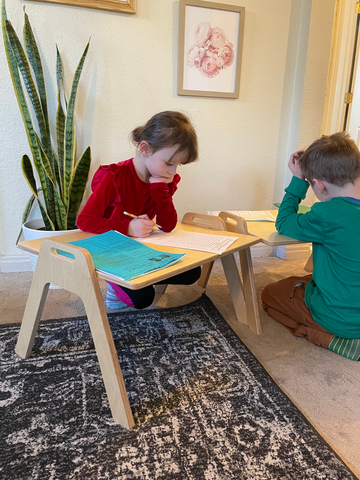What makes a space “Montessori”?
“Small or difficult spaces are opportunities for creativity.” - The Montessori Baby, Simone Davies and Junnifa Uzodike
It may seem intimidating to design a Montessori space for babies and children in a small apartment, but even the smallest home can be set up to allow independence and freedom of movement for young children! Many of the key principles of Montessori are centered around involving children in the practical activities of life. This will look different for each family because we all live drastically different lives in different spaces. If you can find creative ways to involve children in the home, you're creating a Montessori space! So, they don't necessarily need their own child-sized kitchen, craft room, or bathroom vanity; they just need thoughtfully prepared ways to access their home in whatever way works. Keep in mind that a home space does not need to be set up the same as a Montessori classroom would, that isn't always a realistic expectation! We can look to basic Montessori principles for guidance, and of course, use a little creativity.
A Sense of Order
Maria Montessori wrote that the Sensitive Period for Order begins at birth, peaks during early toddlerhood, and lasts until around age five. This means that young children thrive when there is a sense of predictability in their environment. Following the principle of having a place for everything gives children reassurance and independence. Any space can be organized no matter its size! While Montessorians generally try to display items for young children out in the open, so that they’re visible (such as an open wardrobe, open shelving, etc.), closed storage can help a small space feel less cluttered. You can also look for under-utilized empty spaces for storing things that don't need to be accessed frequently to free up floor space for your child. For instance, storing things under beds, putting shelves up high and out of the way, and using wall space for storage (this slot board is very versatile and sturdy for storage and work spaces!) However, you choose to organize, try to find ways to keep your children's items accessible to them and teach them how and where to reach their items.

Photo: @missymontessori
Supporting Independence
We can support children’s developing independence in any sized space by making items like toys, clothes, shoes, and tableware accessible in a place that children can safely reach all by themselves. You might also utilize step-stools and accessibility aids so that they can independently function in adult-sized spaces.
You can offer a child the bottom drawer of a dresser or the bottom shelf of a closet for their clothes. They can have a shelf or drawer in a kitchen that is just for their dishware, and the bottom shelf of a shoe rack for their shoes. A low shelf or drawer in the refrigerator can be stocked with snacks that children can reach themselves. Try getting down to your child’s level to see what’s visible to them, and what they can and cannot access independently. Not everything needs to be (or should be) accessible, but the Montessori way encourages giving children opportunities to learn through work, so finding unique ways that work for you to participate more fully in their homes can help make a more Montessori-aligned space.

Getting Creative
Incorporating versatile pieces into a small space can be transformative. While you might not have room for multiple child-sized items, items can often be used for multiple purposes.
A child-sized table and chair or stool can be used for crafts and for eating snacks. It can also serve as a flat surface for children to practice folding clothes on. That same chair or low stool can be used to put on shoes when preparing to leave the house. You might consider this Adjustable Montessori Weaning Chair & Table Set which can grow as your child does. If your space doesn’t have room for a child-sized table and chair, then the combination of a Large Chowki Floor Table and Stubby Stool might be just the right fit. Younger children can sit on the 9” Stubby Stool while using the Chowki, while older children can sit on the floor while using the Chowki. The stool can also be used to put on shoes and socks. Both items can be easily transported by children to just the right spot in the house.
If your space is used by both children and adults throughout the day, look for items that can be packed and stored away in the evening after children go to bed.

Montessori as Inspiration
Each family's space is unique, just like each family's needs are unique. By using the Montessori principles of creating a sense of order and supporting independence and freedom of movement, as well as utilizing items for multiple purposes, we can transform a space of any size into a Montessori-aligned space for children!
Do you live in a small space? What space-saving tricks have you tried at home?




